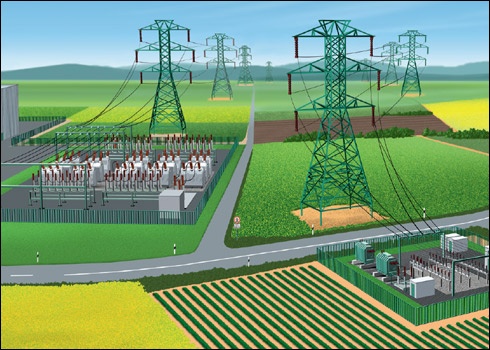Network Redundancy for Today’s Substations Communications
Have you ever left just one phone number you can be reached at with someone that will absolutely need to get ahold of you in an emergency? Probably not. When it is absolutely critical that a message reach you, you leave a second number as a back-up, just in case.
Your industrial network is no different. To avoid the risk and expense of system outages and downtime, ensure your communications (and operations) keep flowing with a back-up or redundant networks.
So where should you look to implement a redundant network? If cost was no issue, you’d do it everywhere. But where it really matters is where a single point of failure could bring down all of the communications. Single points of failure can be minimized with proper network segmentation.
Dividing up large networks into smaller groups improves manageability, reliability and service. It also helps to avoid a single failure in one sub-network taking out everything.

But even with proper segmentation, you’ll still have some single points on failure that are hard to get around. For example, there typically may be only a single network connection between a master control house and the remote substation.
If that link goes down, there is no way to communicate. It’s in places like these where adding a redundant network scheme makes the most sense, no matter if the communication technology is Ethernet WAN, Cellular 3G or MPLS-PPP WAN.
The other place to look for the impact of a single point of failure is when the communication is being used for real-time control of protection devices in the substation. With the growing adoption of IEC 61850 in the substation, effective protection and control of the equipment would be lost if one of the Ethernet links went down.
In cases like these, a no packet loss form of redundancy such as PRP and HSR would be what’s needed. But I’m getting ahead of myself a bit. Let’s take a look at three of the most useful redundancy schemes along with their pros and cons.
Redundancy Protocols: The Pros and Cons
Three redundancy schemes for substations:
- Rapid Spanning Tree Protocol (RSTP)
- Cellular Redundancy
- Parallel Redundancy Protocol (PRP)
| Protocol | Works Best On | Pros | Cons |
|---|---|---|---|
| Rapid Spanning Tree Protocol (RSTP) (IEEE 802.1D-2004) |
Any Ethernet WAN | Can implement on any topology or mesh | Potentially long recovery, 5-20ms per switch |
| Cellular Redundancy | When a second hard wired Ethernet line is not available | Provides alternative to running a physical line for redundancy | Potentially long recovery. Dependent upon wireless internet |
| Parallel Redundancy Protocol (IEC 62439-3:2012-07) |
Any Ethernet WAN | Zero packet loss. "Oms" recovery. Can be added to any existing network. | Requires separate redundancy boxes. |
Summary of redundant communication network options
Rapid Spanning Tree Protocol
Detecting Network Breaks and Re-Enabling Links
RSTP uses a physical ring, but disables one link to prevent messages from being forwarded on and causing message looping. If the network detects a break, the disabled link will be re-enabled and your messages can then flow through the network using the new path. The main advantage of this technique is that it can be used on any network topology.
Cellular Redundancy
Saving Lost Hardwired Ethernet
When it’s not possible or practical to add a separate physical hardwired Ethernet line, you can use cellular redundancy to provide a means of backing up communication. The cellular link will remain in a standby mode until communications through the primary hardwired Ethernet line is lost. Then, your communication will be transferred to the cellular link.

Data flows over the Cellular Redundant network if connection to the hardwired network is lost.
Parallel Redundancy Protocol
Zero Packet Loss
PRP requires the addition of a “redundant box,” or “red box” for short. As traffic comes into the red box, it duplicates the message packet. One packet is sent over one network, the second is sent over the other. The red box on the other end forwards the first message it receives to its destination and discards the duplicate when it arrives.
In the event of a network failure on one of the links, the message continues to be sent over the link that is still up. This means no packets are ever lost, even if there is a communication failure on one of the links. No devices on either end will see a delay in receiving packets.

PRP is particularly useful for master to substation communication.
Need for Redundancy
Now that you know your redundancy options, do you know your own utility’s need for redundancy? Use our simple, quick evaluation tool below. We call it the “unplanned downtime calculator” and it can help make the case to your boss, team or executives for investing in redundancy.
| Unplanned Downtime Calculator | |||||
|---|---|---|---|---|---|
| $ | X | product value | per | Y | unit of time, e.g. hour |
| times | |||||
| V | average Meant Time to Repair - MTTR (in same time units as above) |
||||
| times | |||||
| W | # of downtime events per year | ||||
| equals | |||||
| $ | Z | per year of downtime expense | |||
Ultimately, whichever networking technology you choose, robust and redundant communication will keep your small issues small and ensure high availability of your systems.
![System.String[]](https://assets.belden.com/transform/7d9664bf-965d-4965-a32d-382a9829c061/Author-Belden-Logo-sm-blue-2020-10?io=transform:fill,width:300,height:300)